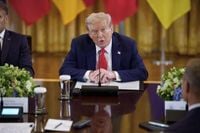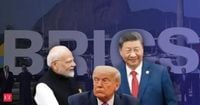On the eve of a pivotal geopolitical season, the world’s trade and diplomatic order is being tested as the United States, under President Donald Trump, imposes sweeping tariffs on key partners—Brazil and India—fueling both confrontation and unlikely cooperation among major global players. The latest developments have not only triggered legal maneuvers at the World Trade Organization (WTO) but have also nudged historic rivals India and China toward a rare alignment, reshaping the landscape of international relations in the process.
On August 18, 2025, the United States slapped 50% tariffs on most Brazilian imports, a move that immediately drew the ire of Brazilian officials and prompted Brazil to request formal consultations at the WTO. The U.S. response, filed the same day, accepted Brazil’s request for talks but firmly argued that the tariffs were rooted in national security concerns—matters, it claimed, that are “political and not susceptible to review or capable of resolution by WTO dispute settlement,” as reported by Reuters. According to the U.S. filing, the measures were necessary because “recent policies and practices of Brazil are undermining the rule of law and threatening the national security, foreign policy, and economy of the United States.”
This invocation of national security as a trade defense is not new, but it’s rarely used with such sweeping scope. The U.S. has linked these tariffs not only to economic disputes but also to Brazil’s internal policies and the ongoing legal troubles of former President Jair Bolsonaro. The move has sent ripples through the global trading system, raising concerns about the precedent it sets for bypassing established WTO mechanisms and the potential for tit-for-tat escalation.
Brazil, for its part, has maintained that the U.S. tariffs are unjustified and risk undermining the global rules-based order. The dispute now heads into the WTO’s consultation phase, a process that could take months—or longer—given the U.S. insistence that its actions are exempt from WTO scrutiny. Meanwhile, Brazilian exporters and U.S. importers are left in limbo, uncertain about the future of billions of dollars in annual trade.
But Brazil is not alone in facing Washington’s tariff barrage. Just a day after the Brazil-U.S. standoff went public, India found itself in a similar bind. On August 19, 2025, President Trump doubled down on his tariff campaign, imposing a 50% levy on Indian exports—a dramatic escalation from the 25% tariff announced the previous month. The justification? India’s continued import of Russian oil, which the Trump administration has characterized as undermining Western efforts to isolate Moscow. The move has rattled not only New Delhi but also the broader BRICS bloc, which includes Brazil, Russia, India, China, and South Africa.
Trump has made no secret of his skepticism toward BRICS, singling out the group as a threat to U.S. influence and warning against what he calls its “anti-Western agenda.” According to The Economic Times, his actions have “cast a long shadow” over ongoing trade talks and have ironically pushed India and China—often at odds over border disputes and regional competition—toward closer cooperation.
The Ministry of External Affairs in India announced on August 19 that China would support India’s hosting of the 2026 BRICS Summit, while India would back China’s own summit in 2027. This reciprocal pledge, while procedural on the surface, is being interpreted as a strategic signal: the bloc will not be splintered by U.S. pressure. In the words of a senior Indian diplomat, “It is a message that BRICS unity remains intact, despite external attempts to divide us.”
Economist Jeffrey Sachs, speaking to The Economic Times, minced no words in his assessment of the U.S. approach. Describing Trump’s tariff decisions as “bizarre” and “very self-destructive of US foreign policy interests,” Sachs warned that the measures could face serious legal hurdles and risk years of progress in U.S.-India relations. “It’s a shocking level of incompetence. I see incompetence in the US government, I’m never surprised, but I’d say that this reached this level that I have to admit actually surprised me,” he remarked, specifically criticizing the doubling of tariffs on Indian goods. Sachs also stressed that these tariffs violate international law and undermine the U.S. Constitution’s provisions on trade, stating, “Tariffs are wrong in that they’re destructive for the US economy. It violates international law. It’s a breakdown of our political system in the United States. We have a constitution. We don’t have one-person rule.”
Amid this turbulence, India and China have seized the moment to push forward their own bilateral agenda. Prime Minister Narendra Modi, after meeting with Chinese Foreign Minister Wang Yi, accepted President Xi Jinping’s invitation to attend the Shanghai Cooperation Organization (SCO) Summit in Tianjin on August 31 and September 1, 2025. Modi described the invitation as an opportunity to “continue the momentum” from previous talks, emphasizing that “stable, predictable, constructive ties between India and China will contribute significantly to regional as well as global peace and prosperity.”
The two Asian giants also agreed to resume direct flights, update their Air Services Agreement, and ease visa restrictions for tourists, business travelers, media, and pilgrims. Notably, Beijing agreed to expand Indian pilgrimages to Kailash Mansarovar starting in 2026 and to share hydrological data during emergencies as part of their cooperation on trans-border rivers. The countries will also reopen border trade through three Himalayan passes—Lipulekh, Shipki La, and Nathu La—and mark the 75th anniversary of diplomatic ties in 2025 with joint events.
On security, both sides committed to deepening military and diplomatic consultations. National Security Advisor Ajit Doval and Wang Yi reviewed the situation along the Line of Actual Control, noting that “borders have been quiet, there has been peace and tranquillity, our bilateral engagements have been more substantial.” An Expert Group will be established to work on early delimitation measures, and new General Level Mechanisms will be created in the eastern and middle sectors of the border. While around 50,000 to 60,000 troops remain deployed along the eastern Ladakh stretch, the standoff that began in 2020 has largely subsided, with both sides reporting an “upward trend” in ties over the past nine months.
Of course, challenges remain. India raised terrorism as a major concern, especially cross-border attacks, and flagged China’s construction of a mega dam on the lower reaches of the Yarlung Tsangpo (Brahmaputra), warning of its impact on downstream states. Wang Yi agreed that the fight against terrorism should be given “the highest priority,” signaling at least rhetorical alignment on a contentious issue.
As the world watches, the confluence of trade wars and diplomatic realignments is reshaping old alliances and forging new ones. The U.S. tariffs have not only triggered legal and economic disputes but have also inadvertently fostered dialogue and cooperation among America’s rivals. With the fate of multilateralism hanging in the balance, the coming months promise to be a defining chapter in the global order’s evolution.






